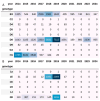The Global Measles and Rubella Laboratory Network Supports High-Quality Surveillance
- PMID: 39204069
- PMCID: PMC11359298
- DOI: 10.3390/vaccines12080946
The Global Measles and Rubella Laboratory Network Supports High-Quality Surveillance
Abstract
With 762 laboratories, the Global Measles and Rubella Laboratory Network (GMRLN) is the largest laboratory network coordinated by the World Health Organization (WHO). Like the Global Polio Laboratory Network, the GMRLN has multiple tiers, including global specialized laboratories, regional reference laboratories, national laboratories, and, in some countries, subnational laboratories. Regional networks are supervised by regional laboratory coordinators reporting to a global coordinator at WHO headquarters. Laboratories in the GMRLN have strong links to national disease control and vaccination programs. The GMRLN's goal is to support member states in obtaining timely, complete, and reliable laboratory-based surveillance data for measles and rubella as part of the strategy for achieving measles and rubella elimination. Surveillance data are reported to the national program and are included in annual reports on the status of measles and rubella elimination to national verification committees for review by regional verification commissions. Quality within the GMRLN is ensured by monitoring performance through external quality assurance programs, confirmatory and quality control testing, accreditation, and coordination of corrective action and training where needed. The overall performance of the laboratories has remained high over the years despite many challenges, particularly the COVID-19 pandemic. The GMRLN is well-positioned to support high-quality laboratory-based surveillance for measles and rubella and to transition to supporting laboratory testing for other pathogens, including vaccine-preventable diseases.
Keywords: PCR; WHO; diagnostics; measles-rubella laboratory; network; serology.
Conflict of interest statement
Author David Featherstone was employed by the company Consultant Scientists Ltd. The remaining authors declare that the research was conducted in the absence of any commercial or financial relationships that could be construed as a potential conflict of interest.
Figures



Similar articles
-
Global Measles and Rubella Laboratory Network Support for Elimination Goals, 2010-2015.MMWR Morb Mortal Wkly Rep. 2016 May 6;65(17):438-42. doi: 10.15585/mmwr.mm6517a3. MMWR Morb Mortal Wkly Rep. 2016. PMID: 27148917
-
Global and national laboratory networks support high quality surveillance for measles and rubella.Int Health. 2017 May 1;9(3):184-189. doi: 10.1093/inthealth/ihx017. Int Health. 2017. PMID: 28582561 Review.
-
Genetic Characterization of Measles and Rubella Viruses Detected Through Global Measles and Rubella Elimination Surveillance, 2016-2018.MMWR Morb Mortal Wkly Rep. 2019 Jul 5;68(26):587-591. doi: 10.15585/mmwr.mm6826a3. MMWR Morb Mortal Wkly Rep. 2019. PMID: 31269012 Free PMC article.
-
Building Quality Control for Molecular Assays in the Global Measles and Rubella Laboratory Network.Vaccines (Basel). 2024 Jul 23;12(8):824. doi: 10.3390/vaccines12080824. Vaccines (Basel). 2024. PMID: 39203950 Free PMC article. Review.
-
Expansion of the measles and rubella laboratory network, India.Bull World Health Organ. 2022 Apr 1;100(4):247-255. doi: 10.2471/BLT.21.286999. Epub 2022 Feb 3. Bull World Health Organ. 2022. PMID: 35386556 Free PMC article.
Cited by
-
Progress Toward Measles Elimination - Worldwide, 2000-2023.MMWR Morb Mortal Wkly Rep. 2024 Nov 14;73(45):1036-1042. doi: 10.15585/mmwr.mm7345a4. MMWR Morb Mortal Wkly Rep. 2024. PMID: 39541251 Free PMC article.
References
-
- World Health Organization Expanded Programme on Immunization (EPI). Standardization of the nomenclature for describing the genetic characteristics of wild-type measles viruses. Relev. Epidemiol. Hebd. 1998;73:265–269. - PubMed
-
- Mulders M.N., Rota P.A., Icenogle J.P., Brown K.E., Takeda M., Rey G.J., Ben Mamou M.C., Dosseh A.R., Byabamazima C.R., Ahmed H.J., et al. Global Measles and Rubella Laboratory Network Support for Elimination Goals, 2010–2015. MMWR. Morb. Mortal. Wkly. Rep. 2016;65:438–442. doi: 10.15585/mmwr.mm6517a3. - DOI - PubMed
-
- MeaNS and RubeNS. [(accessed on 11 July 2024)]. Available online: https://who-gmrln.org/
-
- Association of Public Health Laboratories Vaccine Preventable Diseases. [(accessed on 12 July 2024)]. Available online: https://www.aphl.org/programs/infectious_disease/Pages/VPD.aspx.
Grants and funding
LinkOut - more resources
Full Text Sources

